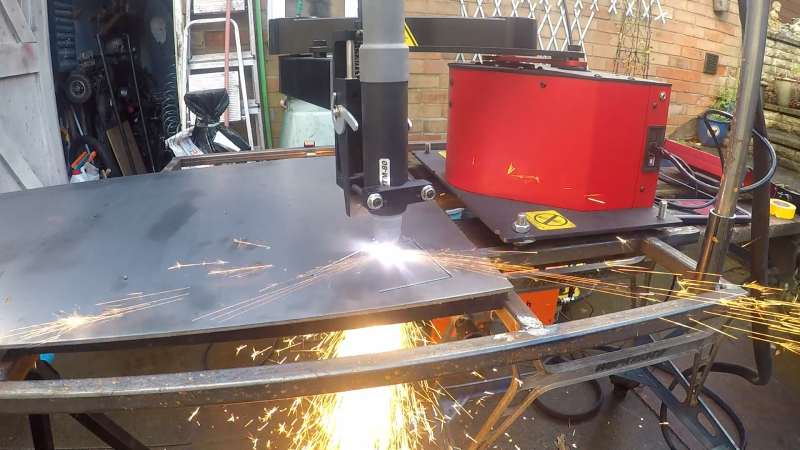Metalworking has always been very much a “mixed method” art. Forging, welding, milling, grinding; anything to remove metal or push it around from one place to another is fair game when you’ve got to make something fast. Adding in fancy new tools like CNC plasma cutting and computer-aided drafting doesn’t change that much, although new methods often do call for a little improvisation.
Getting several methodologies to work and play well together is what [tonygoacher] learned all about while trying to fabricate some brackets for an electric trike for next year’s EMF Camp. The parts would have been perfect for fabrication in a press brake except for the 4 mm thickness of the plate steel, which was a little much for his smallish brake. To make the bending a little easier, [tony] made a partial-thickness groove across the plasma-cut blank, by using a reduced power setting on the cutter. This worked perfectly to guide the brake’s tooling, but [tony] ran into trouble with more complicated bends that would require grooves on both sides of the steel plate.
His solution was to 3D print a couple of sacrificial guide blocks to fit the bed of the press brake. Each guide had a ridge to match up with a guide groove, this allowed him to cut his partial grooves for both bends on the same side of the plate but still align it in the press brake. Yes, the blocks were destroyed in the process, but they only took a few minutes to print, so no big deal. And it’s true that the steel tore a little bit when the groove ended up on the outside radius of the bend, but that’s nothing a bead of weld can’t fix. Good enough for EMF is good enough, after all.
The brief video below shows the whole process, including [tony]’s interesting SCARA-like CNC plasma cutter, which we’re a little in love with now. This isn’t the first time we’ve seen 3D prints used as tools in metalworking, of course, but we picked up some great tips from this one.

















I feel like the partial depth of cut with the plasma cutter was a good idea, putting internal chamfers on thick bent pieces is common. I think doing it with the plasma cutter likely made the sheet metal brittle hence the cracking. Maybe if he tempered it with a blowtorch it’d be easier.
I don’t think 4mm thick steel is sheet metal. That’s plate steel at that thickness.
in the pressbrake industry metal sheet is defined as something notably larger than it is thick… and it’s just a matter of using the correct pressbrake… I’ve seens some 40mm steel sheet being formed and they still consider that metal sheet btw.
Partially cutting the sheet might be a way to make it bendable, but that will render the thickness useless, it won’t be more resilient as the smallest thinkness in the groove, if you remove, let’s say 2mm, you’d be just as well served by using 2mm sheets and avoiding the need of groove altogether. in fact, by having that part lasered in the middle it might even be less resilient that the equivalent thikness plain sheet. kudo for the inventivness, and sacrificial die is a nice and proven way to get some things done!
Cool idea. though if you don’t have a 3DP, you could plasma cut an alignment guide out of thinner metal rather than 3D print it.
The arm-style plasma cutter deserves a write-up of its own, it’s an interesting idea for those of us with space-constrained workshops and likely accurate enough for the average hobby plasma setup.
For the reverse side alignment making two one inch low power marks on either side of the bend line would reduce your weakness while still allowing you to use your printed parts.
To me it would have been far easier to simply cut a dashed line all the way thru the metal along the bend, thereby not requiring the sacrificial blocks for the press, and he planned on welding the bended result anyway. And let’s give some props to the ArcDroid CNC Plasma cutter!!